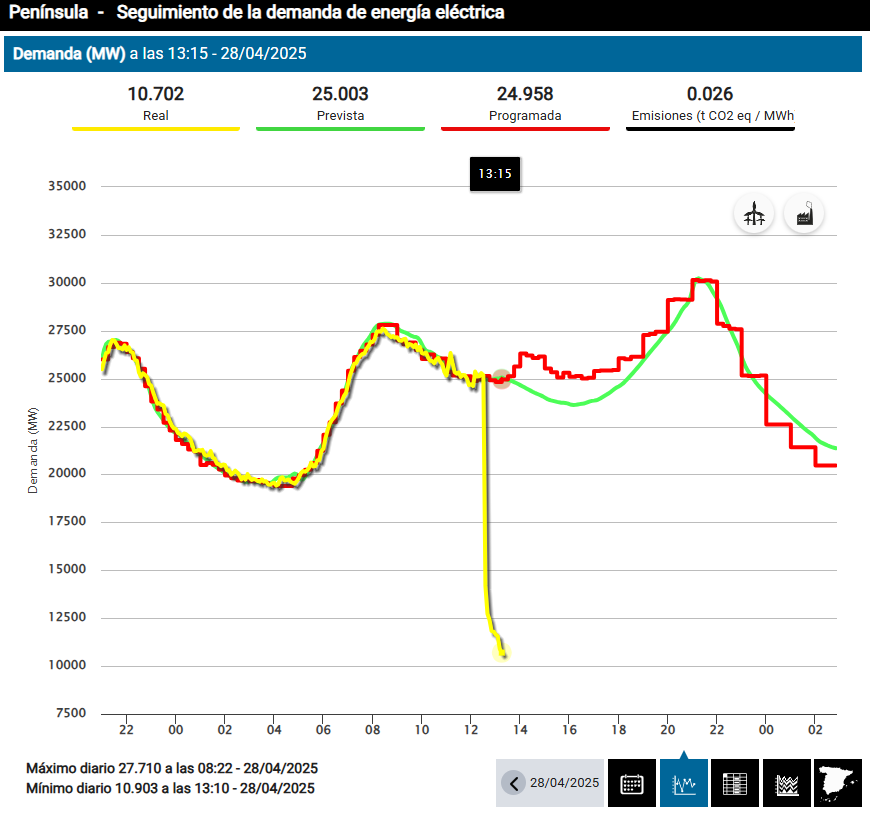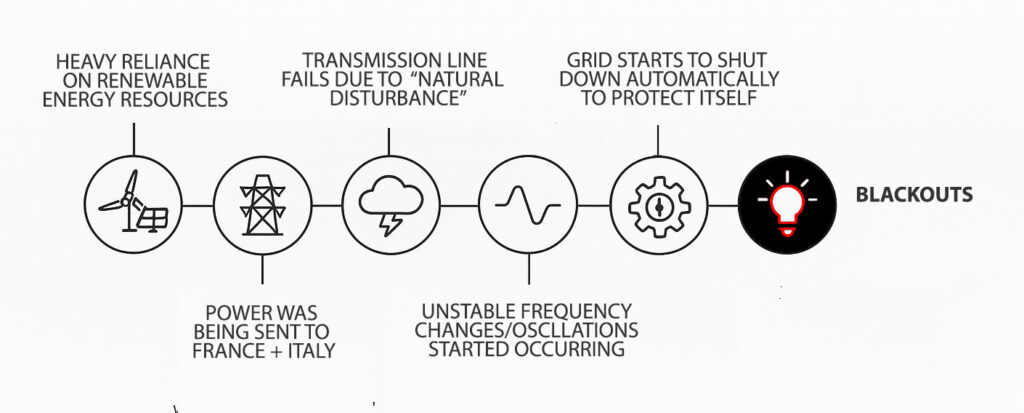In retrospect, the celebration over a major renewable energy milestone in Spain a little more than a week ago was a little premature. The widespread power outage across Spain and Portugal is a fresh reminder of the risks and challenges of integrating renewable energy sources into power grids across the world.
***
On April 28th at 12:33 PM local time (5:33 AM Central), millions of homes and businesses across the Iberian Peninsula suddenly went dark. The modern life of 55 million people came to a screeching halt.

This chart — “Peninsula – Monitoring of Electricity Demand” from Spanish grid operator REE — shows electricity demand from April 27th at 10 PM through 2 AM on April 29th. Green is forecasted demand, red is scheduled demand, and real demand is shown in yellow.
 Spanish grid operator Red Eléctrica de España (REE) initially cited a massive “disconnection event” in southwestern Spain — this “event” resulted in cascading disruptions across the interconnected Iberian power system.
Spanish grid operator Red Eléctrica de España (REE) initially cited a massive “disconnection event” in southwestern Spain — this “event” resulted in cascading disruptions across the interconnected Iberian power system.
While early speculation included cyberattacks or equipment failure, Spain’s REE later stated that a significant frequency deviation and generation/load imbalance was a leading factor. A cyberattack was ruled out fairly quickly.
While the exact cause of the outage remains under investigation, preliminary analyses suggest that grid instability developed by an oversupply of renewable energy may have been the leading factor. The large presence of solar and wind power generation at the time may have left the system more fragile, unable to absorb sudden shocks or disruptions without support from more conventional, traditional power sources.
Right before the power outage, Spain and Portugal were relying primarily on solar and wind power (over 65%), giving the grid very little natural stability or resistance to “fluctuations.”

Grid Stability vs. Instability of Renewable Energy
Modern power systems must continually “match” electricity generation with consumption so to speak. Conventional sources of energy like coal, natural gas and nuclear power plants deliver a steady, constant output of energy. This provides stability to the grid through the rotational inertia of their large turbines.
This inertia plays the role of a buffer in case of fluctuations with the grid, dampening and reducing the impacts of sudden shifts in electricity supply or demand.
By comparison, renewable energy sources like wind and solar produce power intermittently and connect to the grid via inverters, which don’t naturally provide inertia. As these renewable energy sources continue to represent a larger and larger share of energy generation, the grids they power become more prone to swings in frequency and disruptions.
Key Factors and Components of April 28th

- Heavy reliance on renewal energy sources.
The key ingredient of this catastrophic recipe. On April 28th, Spain and Portugal were running and relying on mostly solar and wind power (over 65%), meaning the power grid had very little natural stability (low inertia). The grid was more fragile than usual and more susceptible to “incidents.” - Power was being siphoned to France/Italy.
France and Italy were experiencing high temperatures nearly 20 degrees above average increasing the demand for electricity. When the blackout occurred, Spain was helping meet this excess demand and routing a lot of electricity north to these countries. The transmission lines were almost “maxed out,” leaving little flexibility to handle sudden problems or fluctuations “at home.” - A natural disturbance took down a transmission line.
An unknown disturbance hit one of the biggest 400kV transmission lines in the region causing it to fail — two circuits failed at almost the same time. Foul play isn’t suspected — this could have been caused by strong winds, lightning, wildfires (which were occurring in the vicinity), or equipment failure.This put even more strain on an already strained power grid. - Unstable frequency changes/oscillations started occurring.
This is where inertia played a role. With very little spinning mass on the system (because of so much solar and wind), the typically small wobbles in frequency became more and more unstable instead of calming down. The frequency between Spain-Portugal and the rest of Europe quickly grew apart by over 200 mHz. - Grid automatically, systematically, began to shut down.
Parts of the grid were automatically shut off to prevent damage, and Spain and Portugal became electrically “islanded” — cut off from the main European grid. - Blackouts.
As more and more systems went offline, other systems and generators shut down to protect themselves. Once the dominos stopped falling and power was out for millions, utilities assessed the damage and slowly began the process of restarting and rebuilding the grid — power was restored for most people within 10-14 hours.
Ultimately, this event serves as both a warning and a call to action.
America’s shift toward renewable energy must be carefully examined and thoughtfully managed to ensure our power grids remain stable and reliable. Across the U.S., many states are debating laws to boost renewable power generation. But as this incident highlights, leaning too heavily on any single ‘miracle’ solution can backfire with unintended consequences.
A strong electric grid depends on a diverse mix of power generation sources, each bringing unique strengths to the table:
- Natural Gas: Fuel is stored and transported easily, allowing plants to switch on or off as needed.
- Coal: Relies on affordable fuel but carries environmental costs, though clean coal technology is making strides.
- Nuclear: Requires significant time and investment upfront, yet delivers low-cost energy over decades.
- Wind and Solar: Offer free fuel but face high transmission costs and unpredictable availability tied to weather.
- Hydroelectric: Harnesses flowing water via dams to provide renewable baseload energy and grid flexibility. It’s a major power source, but mostly benefits states like Washington, Oregon, New York, California, and Idaho.
Time and experience have shown that the most resilient grids combine these overlapping sources. This redundancy prevents any single failure, like the one that hit Spain and Portugal, from bringing the whole system down